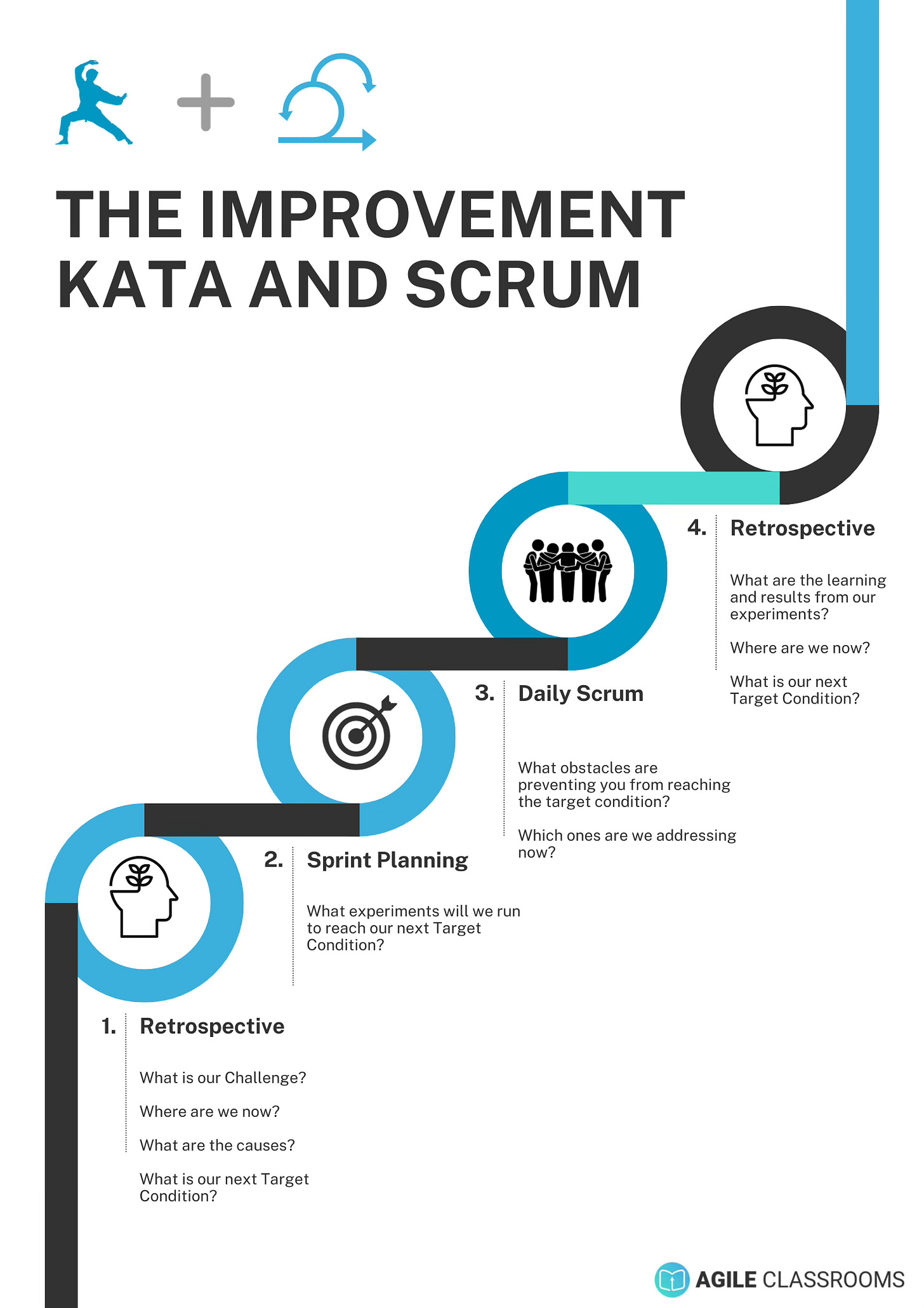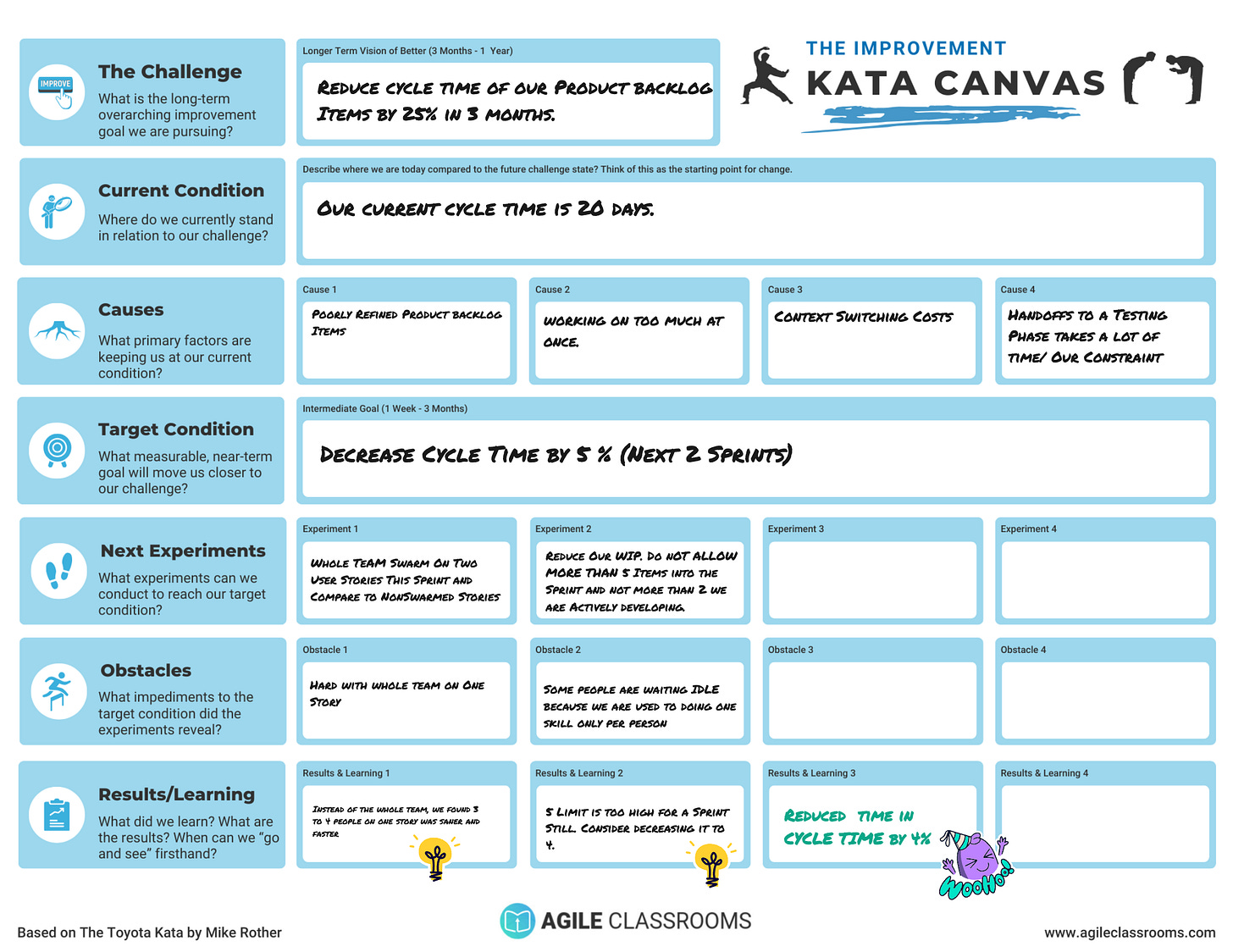Revitalizing Agile Retrospectives with Kata: Part 3
Integrating Scrum with the Improvement Kata
Revitalizing Agile Retrospectives with Kata: Part 3
Our previous articles introduced the Improvement Kata and discussed a real-world example (Part 1: Overview and Part 2: Personal Experience Report and Template). This third installment shifts to its practical application within the Scrum Sprint framework. Here, we outline a method for embedding the structured methodology of the Improvement Kata into Scrum Sprints, thereby enhancing the sprint process. This article details the integration of the Improvement Kata into key Scrum Sprint events, demonstrating how this powerful improvement technique can elevate Agile development practices.
We Are Retrospecting, But Are We Improving?
Sara sat in her office, surrounded by the colorful Miro boards from past retrospectives. The vibrant notes and drawings contrasted sharply with her growing sense of unease.
A year into implementing Scrum, her team’s enthusiasm seemed to have fizzled out. The pace had slowed, and upper management was beginning to question the effectiveness of the process and, implicitly, Sara’s role as a Scrum Master.
As she scanned past retrospectives on the team Miro boards, a pattern emerged - or rather, the lack of one -. Each session went in different directions, sometimes leading to minor improvements, often removing an impediment but often just skimming the surface of deeper issues. Despite Sata being an excellent facilitator, often incorporating fun games, the Retrospectives felt more like isolated attempts at problem-solving rather than steps in a cohesive journey of improvement.
The Revelation
Sara’s conversations with team members revealed a similar sentiment. While they enjoyed the Retrospectives for their engaging and fun nature, most struggled to pinpoint significant changes when it came to concrete improvements since the start of the year. They could point to some impediments that were removed, but removing impediments is not the same as becoming more effective. There were no metrics and no data to back any claims of progress. Sara knew this was a problem, especially with the industry's layoffs wave. She needed to protect her team and her position by proving their value and demonstrating that they were increasing their effectiveness.
Late one evening, an insight struck her as she pondered over this dilemma. The team needed a vision for improvement, akin to a product vision that guided development. They had been reacting to problems and removing impediments but never addressing root causes - like constantly jump-starting a car without changing the battery. Similar impediments resurfaced time after time.
Embracing the Improvement Kata
Sara discovered the Improvement Kata and realized it could be the approach she was looking for. It promised structured problem-solving, measurable goals, a bigger vision of improvement to reach, and addressing underlying causes - everything their Retrospectives were missing. However, she knew introducing another framework amidst Scrum practices would be challenging. She needed to blend it with existing Scrum events.
Sprint Event Alignment with Improvement Kata
Sara devised a strategy to integrate the Improvement Kata and the Improvement Kata Canvas (download it free!) into the Scrum framework. This is what she mapped out:
First Retrospective & Setting The Direction: The cycle begins with the Retrospective, where the team defines their overarching long-term improvement goal, "The Challenge." This step is followed by an assessment of the current condition and its causes. This assessment is crucial for setting a clear "Target Condition," a specific, short-term goal to move closer to the Challenge. If time allows, they may come up with some Experiments to try in the next Sprint.
Sprint Planning and Next Experiments: After establishing the Target Condition, the team considers their next step, leading to the design of experiments. Detailed in the "Next Experiments" section, these experiments are hypotheses about achieving the Target Condition. The team plans which experiments to try and how to conduct them, integrating these into the Sprint Planning process.
Daily Scrum & Obstacle Analysis: During the Daily Scrum, team members discuss obstacles preventing them from reaching the Target Condition. The team adapts their plan for the day accordingly. They may also share any results and learning.
Retrospectives & Continuous Learning: The team's subsequent Retrospective using the Improvement Kata is a time to reflect on the results and learn from the experiments. In subsequent retrospectives, the approach evolves with the team's progress. Achieving the Target Condition leads to setting a new goal and restarting the cycle, always in alignment with the main Challenge. If the Target Condition is unmet, the focus shifts to planning new experiments, overcoming obstacles, and sharing learnings.
Sprinting To Real Improvement
Now that Sara has an approach to introducing the Kata with the Scrum events, she can begin helping her team to implement it.
Retrospective (End of Sprint 1): The Direction & Current State
In the upcoming Retrospective, Sara guides the team in establishing a substantial, long-term improvement goal known as The Challenge in the Improvement Kata framework. She emphasizes the need for an ambitious goal that requires sustained effort, usually over 3 to 6 months. This approach avoids trivial targets and promotes ongoing team growth and development. The team chose 'Decrease cycle time by 25%' as their objective, challenging their existing skills and providing a clear focus for their improvement initiatives.
The team closely examined their Current Condition, the baseline for change. They analyzed their existing cycle times, pinpointing major delay factors, especially prolonged waiting periods. Having tracked the team's Flow Metrics, Sara provided insightful reports to facilitate this review. This led to setting their Next Target Condition: "Reduce cycle time by 5%," a step towards their larger Challenge. This interim goal serves not only as a milestone toward the overarching objective but also as a means to keep the team motivated through tangible, incremental progress.
The team then agreed on their Next Experiments in their upcoming Sprint that they believed would help them achieve their Target Condition of “Reduce cycle time by 5%”. They chose to limit Work In Progress (WIP) and to increase swarming on user stories together versus their usual scatter-gather approach, hoping these strategies would address the identified issues. Sara highlighted the exploratory nature of these experiments. She clarified that in their complex and uncertain work environment, these experiments were not about delivering guaranteed solutions but rather about venturing into uncharted territory to elevate their effectiveness. According to Rother, the creator of the Improvement Kata, experiments are a critical tool for crossing the 'threshold of knowledge' – the point where current understanding ends and new learning begins. By testing these specific strategies, the team was not just trying to fix immediate issues but was also learning, adapting, and evolving their processes.
Sprint Planning (Sprint 2): Designing the Experiments
“You see beyond a knowledge threshold by taking a step (an experiment), not by talking about it.” - Mike Rother
In the subsequent Sprint Planning session, the team leveraged the three topics for Sprint Planning to guide their product development efforts AND their team improvement efforts.
Topic 1: Why is this Sprint valuable?
They reinforced their commitment to their next Target Condition.
Topic 2: What can be done this Sprint?
In addition to selecting product backlog items in Sprint Planning, the team identified specific experiments they would conduct to move closer to their Target Condition. In this case, they swarmed on some stories and limited their WIP in the Sprint.
Topic 3: How will the chosen work get done?
The team delved into the practical aspects of implementing and integrating the chosen experiments into their ongoing product development work for Sprint. For example, “Which stories will we try to swarm on and how?”
By the conclusion of Sprint Planning, they had a well-defined plan that demonstrated their approach to achieving both the Sprint Goal and their Target Condition for the upcoming Sprint.
Implementing the Experiments and Encountering Obstacles
Daily Scrum (Throughout Sprint 1)
According to the Scrum Guide, “the purpose of the Daily Scrum is to inspect progress toward the Sprint Goal and adapt the Sprint Backlog as necessary, adjusting the upcoming planned work. They expanded the Daily Scrum's scope beyond the Sprint Goal. They incorporated their Target Condition, discussed daily experiment activities, shared encountered obstacles, and made necessary adaptations. This adjustment didn't significantly increase the time needed, and they managed to keep it within a 15-minute timeframe.
Sustaining and Expanding Improvements
Retrospective (End of Sprint 2)
In the next Retrospective, Sara and the team had something worth high-fiving about—a 4% reduction in cycle time! That's a solid step towards their big goal of slicing off 25% of cycle time. Yet, just shy of their 5% Target Condition. So, is this a win? You bet! They were better than they were before, and they learned a ton.
The 4% improvement in cycle time is like the wind in their sails, pushing them closer to their big goal. It shows they're on the right track and gives them a boost to take on that remaining 21%. They're jazzed up for the next sprints, ready to keep the good times rolling and the cycle time dropping. They sent their next Target Condition to reduce it by another 5%, continuing with the successful practices and coming up with some new experiments to try.
All along, they updated their Improvement Kata Canvas to make their progress visible, seen below:
Demonstrating Tangible Improvement
Fast forward to the next quarter, and it's time for the company's Operations Review. Many Sprints and Target Conditions later, Sara and her team unveiled their impressive new product release and presented compelling data on achieving a remarkable 20% reduction in cycle time. This accomplishment allowed them to deliver features ahead of schedule despite a temporary slowdown in the early Sprints. The metrics and progress were astonishing, leaving the executives thoroughly impressed.
Other teams couldn't help but ask Sara for the secret behind their success. She attributed it to a dedicated team that was genuinely committed to improvement. She explained how the Improvement Kata had been their guiding light, helping them focus on meaningful enhancements while providing concrete data to illustrate their journey.
Like Sara, you can download your free copy of the Improvement Kata Canvas to take a scientific approach to genuine improvement and effectiveness today.



